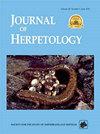德州角蜥(Phrynosoma corntum)背景色匹配研究
IF 0.8
4区 生物学
Q3 ZOOLOGY
引用次数: 0
摘要
摘要大多数关于德克萨斯角蜥蜴(Phrynosoma cornutum)基本生态学的文献都引用了“神秘的颜色模式”作为它们抵御捕食的第一道防线,然而德克萨斯角蜥蜴的颜色与背景的匹配程度从未被量化。几家动物园和国家野生动物机构正在将圈养和迁移的蜥蜴放归它们以前的栖息地。当将蜥蜴转移到一个新的栖息地时,如果它们与当地土壤的颜色不匹配,捕食可能会更高,那么背景颜色匹配可能是重要的考虑因素。我们问蜥蜴是否比其他地区的土壤和茎更符合当地的土壤颜色和阳光漂白的植物茎。我们发现,蜥蜴与当地的土壤颜色比与其他地区的土壤颜色更匹配,它们的脊椎白色条纹与环境中其他物体更匹配阳光漂白的植物茎。我们还根据在野外拍摄的原位照片,展示了德克萨斯州、新墨西哥州和墨西哥这一分类单元的背景颜色匹配变化。我们建议动物园和野生动物机构对其圈养蜥蜴种群的颜色进行评分,从而可能使这些机构能够客观地先验地考虑颜色匹配,作为一种应用的保护策略,以潜在地提高重新引入的德克萨斯角蜥蜴的生存率。本文章由计算机程序翻译,如有差异,请以英文原文为准。
Background Color Matching in Texas Horned Lizards (Phrynosoma cornutum)
Abstract. Most of the literature on the basic ecology of Texas Horned Lizards (Phrynosoma cornutum) cites “cryptic color pattern” as their first line of defense against predation, and yet the degree to which Texas Horned Lizards color match their backgrounds has never been quantified. Several zoos and state wildlife agencies are releasing captive-bred and translocated lizards to parts of their former range. Background color matching may be important to consider when moving lizards into a new habitat where predation may be higher if they are not closely color matched to the local soils. We asked whether lizards more closely match their local soil colors and sun-bleached plant stems than soils and stems from other areas. We found that lizards more closely match their local soil colors than they do the soil colors of other areas and that their vertebral white stripe matches sun-bleached plant stems more than other objects in their environment. We also present background color-matching variation for this taxon in Texas, New Mexico, and Mexico from in situ photos taken, as found, in the wild. We suggest that zoos and wildlife agencies score coloration in their captive populations of lizards, thus possibly enabling these institutions to objectively consider color matching a priori as an applied conservation strategy to potentially increase the survival of reintroduced Texas Horned Lizards.
求助全文
通过发布文献求助,成功后即可免费获取论文全文。
去求助
来源期刊

Journal of Herpetology
生物-动物学
CiteScore
1.60
自引率
0.00%
发文量
45
审稿时长
6 months
期刊介绍:
The Journal of Herpetology accepts manuscripts on all aspects on the biology of amphibians and reptiles including their behavior, conservation, ecology, morphology, physiology, and systematics, as well as herpetological education. We encourage authors to submit manuscripts that are data-driven and rigorous tests of hypotheses, or provide thorough descriptions of novel taxa (living or fossil). Topics may address theoretical issues in a thoughtful, quantitative way. Reviews and policy papers that provide new insight on the herpetological sciences are also welcome, but they must be more than simple literature reviews. These papers must have a central focus that propose a new argument for understanding a concept or a new approach for answering a question or solving a problem. Focus sections that combine papers on related topics are normally determined by the Editors. Publication in the Long-Term Perspectives section is by invitation only. Papers on captive breeding, new techniques or sampling methods, anecdotal or isolated natural history observations, geographic range extensions, and essays should be submitted to our sister journal, Herpetological Review.
 求助内容:
求助内容: 应助结果提醒方式:
应助结果提醒方式:


